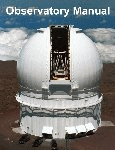 Section
2 - SITE CHARACTERISTICS
Section
2 - SITE CHARACTERISTICS Section
2 - SITE CHARACTERISTICS
Section
2 - SITE CHARACTERISTICS
TABLE OF CONTENTS
WeatherMean minimum temperatures at the summit are around 0 C (summer) and -4 C (winter). Extreme temperatures hardly ever go lower than -10 C. Daytime temperatures are normally about 10 C in summer and 3 C in winter. Weather conditions in the Hawaiian Islands are determined largely by the strong persistent Northeast Pacific Ocean anticyclone, which usually gives rise to easterly (trade) winds in Hawaii, especially during the summer season. Trade winds give an inversion layer with an average height of 2000m; air above this inversion tends to be both dry and stable, hence giving the good astronomical quality usually experienced at the Observatory. At the mesoscale level, the summit of Mauna Kea is generally intercepting a free flow of air, thus preserving this good quality. However, high altitude cirrus can be a problem; in some years it has been present about 30% of the time. The mean annual precipitation at the summit of Mauna Kea is ~15 cm, most of which falls as snow during the winter.
The median seeing
(free atmosphere)
is
~0.40 arc sec, with a likely systematic variation between winter (0.45)
and
summer (0.35). The 10 percentile is probably of the order of 0.25
arc
sec. The summit of Mauna Kea appears to be in
that respect, the best
known
site on earth. Observers must be cautioned, however, that seeing
characteristics
are often
highly variable, even during the course of a single night.
A large sample of
CCD images,
either
at prime or F/8 Cassegrain focus, have allowed good statistical study
of
the
image quality with CFHT. Images are at the subarcsec level at least
75% of the time and long-exposure images with
FWHM better than 0.4
arcsec
have been obtained. The figure below shows the evolution of image
quality
as
documented by science images taken since the beginning of CFHT
operations.
Note that the HRCam and SIS images
have been taken with the
instruments'
fast tip/tilt systems, and that the MOS images are badly under-sampled.

Median image quality
with FOCAM
is slightly
better than 0.8 arc sec. Optical quality of the telescope, dome and
mirror
seeing, image motion and guiding errors play a substantial role, and
the
free atmosphere seeing is usually better as
noted above.
Average sky
brightness at zenith
during dark time is given in the table below.
| Color |
Equivalent |
Brightness [mag/(")2] |
Flux [phot./cm2/s/microns/(")2] |
| U B V R I J H K |
0.36 0.44 0.55 0.64 0.79 1.23 1.66 2.22 |
21.6 22.3 21.1 20.3 19.2 14.8 13.4 12.6 |
1.74x10e-2 1.76x10e-2 3.62x10e-2 5.50x10e-2 1.02x10e-1 2.49 4.20 3.98 |

From 1.5 microns to 2.2 microns
the spectrum
of night sky emission is dominated by OH emission lines; between 2.2m
and
2.55m H2O lines and thermal continuum are the dominant contributors.

(2)
Typical spectra, taken from ESO (Chile)
and from UKIRT (Mauna Kea) are included for reference.

Average background
fluxes are
quite variable
in the infrared. Over a few minutes they typically vary by 1% in J, 2%
in H
and 0.3% in K. These figures by T. Gerball, obtained at UKIRT, are
highly variable, however, especially for J and H.
Longward of 2.5
m the background emission is set by thermal radiation from the
telescope
and from the atmosphere.
Mean sky emissivity is 0.35 at 20 m and 0.67
at
27 m.
City lighting is
relatively
small, and
quite often completely damped from cloud cover at the 2000-3000 m
level.
A county
ordinance has been adopted, which restrict most lights of the
Big Island to low-pressure sodium lamps.
For
an interesting look at our night light
environment at CFHT, see The
Light Environment of Mauna Kea.
Extinction and Refraction


Airmass Values
An airmass nomograph for Mauna Kea is given here. Note that a unit airmass at Mauna Kea (with a mean barometric pressure of 605 millibars) is equivalent to 0.60 airmass at sea level.

Astronomical Calendar
The time of sunset and sunrise at Mauna Kea throughout the year, and the corresponding sidereal time are provided in the accompanying figures.


Site characteristics
references


